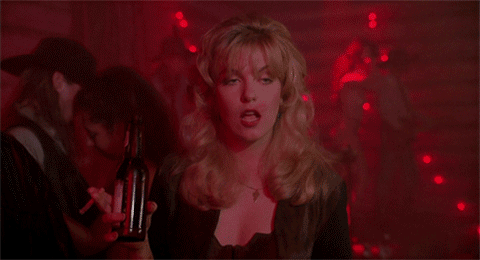Media and Music: The Evocative Jazz of Twin Peaks
Filmmaker David Lynch is known for his surrealism, but when given the green light to bring his weirdness to television — to ABC! — in 1990, Lynch and longtime collaborator Angelo Badalamenti created a soundtrack that grounded the show in human emotions both “wonderful and strange.”
In Media and Music, our writers take a deep dive into how movies use scores and songs to engage viewers, give new meaning and tone to some of our favorite scenes, and establish themes. It almost goes without saying, but there are spoilers abound.
Written by Carys Anderson
Photo courtesy of David Lynch
One of the defining and most charming aspects of “Twin Peaks,” which originally ran from 1990 to 1991, was its jazz score. While the show is set in real time (or 1989, to be exact), the town of “Twin Peaks” maintained a ‘50s vibe, complete with a checkered-floor diner and school girls dressed in pleated skirts and saddle shoes. It only makes sense, then, that Audrey Horne, played by Sherilyn Fenn, would introduce her song “Audrey’s Dance” by playing it on the jukebox at the RR Diner and declaring it “too dreamy.”
This out-of-time feel is central to the show’s multidimensional premise, which complicates viewers’ original understanding of the program as a simple crime drama. It’s also a hallmark of Lynch’s work. Back in the good old days, before streaming services depleted everyone’s patience, “Twin Peaks” would begin with two minutes of opening credits: a slow swelling of synthesizers over images of a bird, a sawmill, a Pacific Northwest waterfall. Unlike many sitcoms, the cast’s faces are nowhere to be found, their names instead appearing over these images as Lynch transports you to his fictional town. The music builds and builds, finally paying off when the show’s title card hits the screen. It’s impossible to know what’s in store for the series to come.
Photo courtesy of Angelo Badalamenti
Beyond the theme song’s beauty and the whimsical ascending and descending scale of “Audrey’s Dance,” the ultimate soundtrack standout is “Laura Palmer’s Theme.” The first episode of “Twin Peaks” begins with Laura Palmer’s (Sheryl Lee’s) death, and yet the mystery and tragedy of a beautiful young girl’s doomed and violent fate fueled three decades of art and cult status. The character’s signature song matches this duality. It begins dark and droning — when it plays throughout the show, it’s usually accompanying bad news. Soon, however, it builds to a happier note, moving up the piano before retreating back into the darkness. There’s a wonderful video of Badalamenti explaining this rise and fall — he recounts Lynch describing a dark forest and a lonely girl. As the girl approaches the camera, the key change represents her beauty. But as she disappears into the trees, the sadness returns.
That girl is Laura Palmer, a glimpse of beauty in a world of evil. With this understanding in mind — the song is burned into our memory from the moment her body is found in the pilot — “Laura Palmer’s Theme” is the most evocative song of the series. It is synonymous with sorrow. “Twin Peaks’” 1992 prequel movie “Twin Peaks: Fire Walk With Me” leaned into this darkness with its focus on Laura’s final days, subsequently losing much of the small-town charm the series showed in its early episodes. This emphasis on the dire is mirrored in its score. The theme of “Fire Walk With Me,” like “Laura Palmer’s Theme,” has an underlying drone that adds to the film’s sense of dread. The smoky saxophone on top mimics the loneliness Laura feels throughout the film.
“The Pink Room” is another standout from the score for “Fire Walk With Me.”Its old-time rock-and-roll guitar plays up the sense of danger prevalent in the scene it scores, in which Laura and Donna have sex with the Renaults in the Pink Room. The bowed bass adds an uncomfortable dissonance to the music, also present in the scene. It’s jarring to see Laura fully succumb to her self-destructive tendencies in the face of her abuse, and to subject her best friend to it as well. The rawness of scenes such as this one led “Fire Walk With Me”to find a much colder embrace than the relatively tame “Twin Peaks” series.
Photo courtesy of WiffleGif
When “Twin Peaks” returned to television in 2017, many expected to be transported back to the famous town Lynch created, complete with the nostalgic score that shaped it. They could not have been more wrong. “The Return” doubles down on Twin Peaks’ theories of multiple dimensions and timelines, with several hours of the 18-episode season taking place away from the town and with completely new characters. For this reason, Lynch pairs his confusing offering with more sounds than music: eerie electric hisses replace the orchestras of yore. The most memorable compositions come from new artists altogether, as Lynch introduced a performance motif at the end of each episode in which real-life bands played at the Roadhouse bar.
Perhaps the most affecting use of music in “The Return” is in Episode 8, one of the revival’s standouts. The abstract hour likens the creation of BOB — the manifestation of all human evil — to the creation of the atomic bomb. Over black and white footage of the test explosion in White Sands, New Mexico in 1945, Witold Rowicki’s “Threnody for the Victims of Hiroshima” screams. It’s a heavy metaphor, and the chaos of the composition’s strings fit the uncomfortable fictional truth that Lynch is offering.
“Fire Walk With Me” was a surprising leap from “Twin Peaks” the series, and “The Return” was equally stupefying. Along the way, Lynch and Badalamenti soundtrack the grief on the screen and the perplexion in the viewer. To compose an instrumental soundtrack as evocative as this one is a great feat — they don’t sell it on vinyl for nothing.



